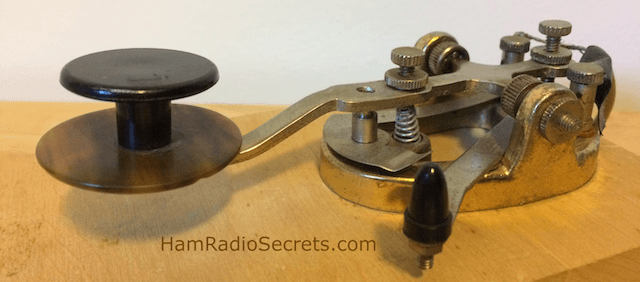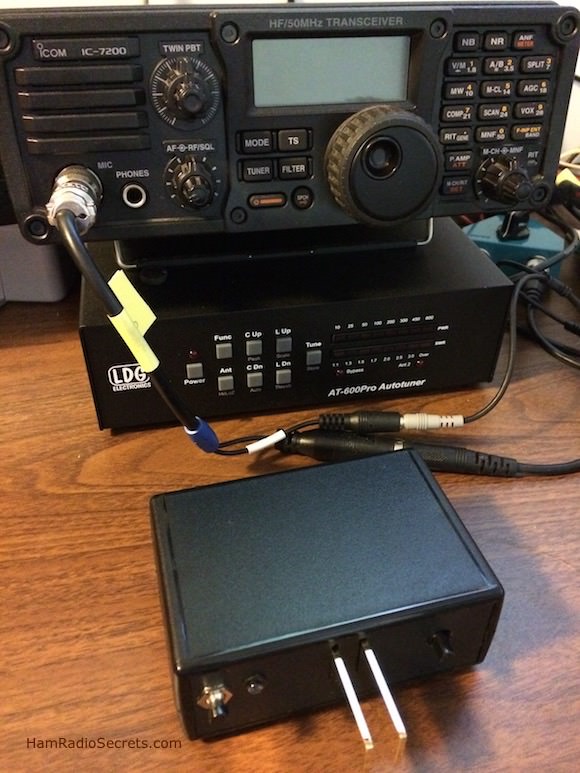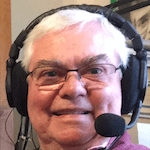QRP CW
in a Nutshell
In my opinion, QRP CW is one of the most challenging aspects of ham radio. Because it is, I find it to be one of the most rewarding modes of operation.
This page is dedicated to those who are new to CW - especially at QRP (maximum 5 watts) power levels - and to those who are thinking of coming back to CW after years of exile in SSB land.
The satisfaction of making solid contacts with a power output of 5 watts or less is unequalled. I would compare this mode of operation to fly fishing in river rapids. It demands:
- Skill in tuning in a weak CW station carefully (this takes a little practice).
- Skill in sending good clean morse code and reading CW sent by the other station accurately.
- Patience to make yourself heard when sending CQ or answering one.
- Patience to make solid contact and complete a QSO.
- Determination to keep practicing to improve your skills.
QRP CW does not require much in terms of equipment and the total cost can be minimal.
- A small CW transceiver (more useful when operating portable than separate QRP transmitter with its companion receiver).
- A simple wire antenna - preferably resonant at the operating frequency. If it is not, you must use a very efficient antenna system tuner. To be very efficient, a tuner must have very high-Q inductor(s).
- A power source (a battery, a spare charged battery and perhaps even a small solar panel to charge them).
- A straight key or paddle key.
It will always amaze me to be able to make contact with amateur radio stations hundreds, if not thousands of miles away, with so little power and a very simple wire antenna.
The Power of QRP CW over SSB
Many hams believe that one needs at least 100 watts of output power and even an antenna offering some gain - such as a directional multi-element antenna (i.e. a yagi) - to be able to make solid contacts on a regular basis.
Did you know that a 5 watt signal is only two (2) S-units below a 100 watt signal? Here are some interesting observations.
Paul, W0RW, mentions in the NAQCC Newsletter issue 258 of December 2019, that "The effective gain for CW vs SSB has been calculated at +18 dB".
N1FN had also postulated as much in an article first published in "73 Amateur Radio" Issue #474, May 2000, that can still be found here: http://www.morsex.com/pubs/qrp.htm
On the other hand...
John Shannon K3WWP ( http://home.windstream.net/johnshan/cw_ss.html ) submits an interesting mathematical demonstration by which he arrives at "... a 100 watt 25 WPM CW signal having a +13 dB advantage over a 100 watt 2000 Hz SSB signal". He concludes from that "... a 5 watt CW signal packs an equivalent punch to a SSB signal at 100 watts".
Kazimierz “Kai” Siwiak, KE4PT, and Bruce Pontius, NØADL, in an article published in Dec 2013 QST magazine titled "How Much “Punch” Can You Get from Different Modes?" ( https://www.qsl.net/k4fk/presentations/Mode-sensitivity-2013-Dec-QST-Siwiak-Pontius-1.pdf ) concludes that: "... CW can outperform unprocessed SSB by 17 dB".
RSGB.org also indicates that:
"A CW signal can have more than a 10-20 dB advantage over a SSB signal (depending on which book you read)". ( https://rsgb.org/main/get-started-in-amateur-radio/operating-your-new-station /morse-code-is-still-worth-learning-but-why/ )
Obviously, the measured and/or perceived gain (in dB) that CW has over SSB depends on the methodology and the power references used.
All (who bothered to look into it more closely) agree that CW QRP has noticeable, if not significant gain over SSB.
Sceptical? Try running a few tests on the air sometime using a WebSDR receiver station to monitor your signals at different power levels. You will be amazed and for ever convinced that QRP CW is really a powerful mode of communication.
The Weak Signal Propagation Reporter Network (WSPRnet) map clearly demonstrates that very little RF power is required to cover amazing distances, across large countries like the United States and Canada, and also span distances separating continents like the Atlantic Ocean between North America and Europe.
QRP CW FREQUENCIES
By convention the following calling frequencies have been earmarked for CW operation at QRP levels in North America (IARU Region 2) - within the amateur radio frequency bands, of course.
Note: In the present context, a convention is a gentleman's agreement formed by flexible consensus among ham radio CW operators, clubs and national organization (1.e. ARRL, RAC). As always, proper operating procedure is to listen ... before asking if the frequency is in use (QRL?). If no one answers, then you can transmit a CQ.
BAND Freq (MHz)
160 1.812
80 3.560 (Note: QRS center of activity 3.555 MHz)
40 7.030
30 10.116
20 14.060 (Note: QRS center of activity 14.055 MHz)
17 18.086
15 21.060
12 24.906
10 28.060 (Note: QRS center of activity 28.055 MHz)
6 50.080 - 50.100
2 144.060
70 cm 432.070 - 432.100 (Calling QRG 432.100 MHz)
Factory-Assembled
QRP Transceivers
Please note: I receive no advantage or compensation of any sort from the manufacturers of the equipment mentioned hereafter. I only offer my personal opinion on a few QRP CW transceivers and accessories to illustrate what's available. This list is far from exhaustive.
Admittedly, the following XCVRS pack a lot of "overkill" for QRP CW use. Still, I mention them here because I believe that they are outstanding QRP ham radios for the backpacking enthusiasts. Also, some hams like to have the extra flexibility of other modes of operation.
Elecraft KX2
(http://www.elecraft.com/)
The KX2 covers 9 HF amateur radio bands from 80 to 10 meters. This exciting new QRP rig offers an impressive list of features for its size, some of which are not even available on larger "full-featured" base station transceivers. Worthy of note are:
- Its software defined radio (SDR) receiver section is state of the art technology.
- In addition to CW, the KX2 has three built-in data modes that do not require a PC!
The operator uses CW to transmit data. The KX2 converts the CW to RTTY when in FSK D Mode or converts CW to PSK31 or PSK63 when in PSK D Mode.
The operator just reads the received data on the rig's crisp display. A very ingenious visual CW/Data tuning aid (CWT) enables the op to easily zero-beat CW signals and accurately tune in data signals.
Why do I mention data modes here on a page which should be dedicated to QRP CW? I admit that I also like PSK31 for weak signal communication. I fell in love with the KX2 because I would be able to switch between CW and PSK31 when on camping trips ... without having to lug my heavy laptop! The best of both worlds, at last!
Note that the KX2 is only available factory assembled. Its bigger brother, the KX3, is available in kit form requiring assembly of modules which do not involve soldering.
Elecraft KX3
(http://www.elecraft.com/)
KX2's bigger more sophisticated brother covers 160 - 6 meters and allows operation in SSB/CW/DATA/AM/FM modes.
It is available fully assembled and tested. Another advantage the KX3 has over the KX2 is that the very useful PX3 Panadapter is compatible with it. The PX3's full-colour waterfall and spectrum display makes spotting activity a breeze over up to 200 kHz of RF spectrum at a time.
Yaesu FT-817ND
(http://www.yaesu.com/)
This QRP transceiver is a very compact portable rig with features normally found in many mid-range base station transceivers. It covers 160 to 10 meter HF bands, as well as the 6 meter, 2 meter and 70 cm bands.
It allows operation in CW, SSB, AM and FM modes. However, data modes require a PC. Note that a TNC is also required for RTTY.
TEN-TEC Model 539 Argonaut VI
(https://www.tentec.com)
The TEN-TEC Model 539 Argonaut VI QRP 1-10 Watt Transceiver. Covers 160-10 meters (except 60 and 12 meters).
YouKits (Canada)
(https://youkits.com/)
In spite of the company name, these are not kits but factory assembled QRP rigs.
HB-1B MK3 4 band QRP CW transceiver fully assembled and tested. Covers 40 to 15 meter bands. Allows full CW break-in (QSK).
SK-1A 40M single band SSB CW Transceiver fully assembled and tested.
EK1C 3 band CW transceiver fully assembled and tested. Covers 40, 30 and 20 meter bands.
TJ5A HF 20W SSB CW Transceiver 8 Band version new! Covers 80 to 12 meter bands (no 10 meter band).
DP-1 QRP Digital Power & SWR meter. Fully assembled and ready to use. I have been using the DP-1 for more than a year now. I must say that I am very satisfied with its accuracy and responsiveness.
MFJ Enterprises
(http://www.mfjenterprises.com)
Single band QRP CW Transceivers
(Models MFJ-9015,17,20,30,40)
QRP CUB single band transceivers (assembled)
(Models MFJ-9315W,17W,20W,30W,40W,80W)
QRPver
(https://qrpver.com/transceivers/qrpver_1_v_3.html)
QRPver-1 v.3 HF Mono band mini QRP transceiver (SSB/CW/JT65/PSK/BPSK/FSQ). Available for any HF band and even 6 m and 70 cm bands!
EMTECH
(https://steadynet.com/emtech/)
Famous for its ZM-2 (pre-built) QRP antenna tuners.
QRP KITS
There are countless (I stopped counting anyway) QRP kits out there. QRP transceivers, QRP transmitters with companion receivers - as well as QRP SWR/PWR meters and QRP antenna tuners. Kits, from the simplest to the more sophisticated and complex to build, abound.
Therefore, finding the right kit for you is not an easy task.
So, take the necessary time to browse around. Examine and compare the technical characteristics and the complexity of assembly before choosing your first kit.
If you have never built a kit before, I would recommend that :
- You study these tutorials carefully.
- Then, begin by developing your soldering skills using parts that you can afford to discard if you ruin them.
I said earlier that developing your QRP operating skills was the biggest source of satisfaction. Well, it was not quite true. You stand to multiply your pleasure many times over when you build your own QRP rig from a kit or (if your license level permits) directly from schematics, pre-tested ones or even those of your own design!
Here is a partial list of manufacturers. Some have been around for decades. All of the following are well known by the QRP CW enthusiasts.
ELECRAFT
(http://www.elecraft.com/)
K2 QRP Transceiver - Universally recognized as the all-time classic QRP kit, this rig - in its basic version (CW only) - has too many features to list here. Suffice to say that by the time you have finished building it, it will be worth more than twice what you paid for.
The KX3, already mentioned above in the list of factory-assembled rigs, is also available as a kit. Assembly only involves putting pre-assembled modules together. No soldering required with this one. It does not get any easier than that to save money!
TEN-TEC
(https://www.tentec.com)
Model 507 Patriot – Open Source Arduino-based SSB and CW Dual Band (40 & 20 M) QRP Transceiver.
Model 506 Rebel Open Source Arduino-Based Dual band 40 and 20 meter CW (only) QRP transceiver.
Model 1380 - 80 Meter QRP Transceiver Kit
Genesis Radio
Australia manufacturer: http://genesisradio.com.au/
US Distributor: http://kf1z.com/genesis/order.html
G59 160-6m 10 mW transceiver Kit.
GPA10 10 watt amplifier kit.
Midnight Designs Solutions
(http://www.sdr-cube.com/products.html)
SDR Cube Transceiver - A standalone SDR XCVR for SSB, CW and AM using embedded digital signal processing. No PC required!
Pacific Antenna QRP Kits
(http://www.qrpkits.com/)
This is only a partial list of their kits.
3 Band Portable Field Radio. Covers 40, 30 and 20 meters. CW only.
KD1JV Tri-Bander CW transceiver for any 3 bands from 80, 40, 30, 20, 17 and 15 meters.
Multi-band, Direct Conversion CW Transceiver (MBDC) for 160 and 80 meters.
Ft Tuthill 15m or 160m Single Band CW Transceiver.
Oak Hills Research
(http://www.ohr.com/)
OHR 100A single band CW transceiver kit is offered in 80, 40, 30, 20, and 15 meter versions.
JUMA Kits (Finland)
(http://www.jumaradio.com/juma/)
JUMA-TRX1 is a 5 W DDS controlled CW and DSB transceiver.
JUMA TRX2 High Performance Transceiver.
Breadboard Radio
(http://www.breadboardradio.com/breadboardradio/Products.html)
The “Splinter II” QRPp transceiver for 40 meters.
Bliss Radio
(http://www.nitehawk.com/blissradio/)
Their QRP kits involve soldering and include surface mount parts (SMP).
QRPGuys
(http://qrpguys.apps-1and1.com/para8040set-transceiver)
KD1JV Para80/40set Transceiver - 3 W Crystal-controlled transmitter on 40 or 80 meters, each with two switchable xtal positions: 3.560mHz and 3.5795mHz for 80m -or- 7.030mHz and 7.122mHz for 40m. A sensitive stable regenerative receiver covers about 270kHz of RF spectrum.
QRPme
(http://www.qrpme.com/?p=XCVRS)
Rockmite RM][ Single-band HF transceivers for 20, 40, 30, 20 meters.
They also offer a nifty selection of QRP accessories.
QRVtronics
(http://www.larvell.net/CatHAM_Radio/Products/CRK-10.htm)
The CRK-10 is a 3 watt 40 Meter or 30 Meter CW QRP Transceiver kit. You specify the frequency when ordering.
Vectronics
(http://www.vectronics.com/Categories.php?sub=0&ref=56)
Single band QRP transceivers for 80 m VEC-1380K, 40 m VEC-1340K, 30 m VEC-1330K, 20 m VEC-1320K.
MFJ Enterprises
(http://www.mfjenterprises.com)
QRP CUB single band transceiver kits (MFJ-9315K,17K,20K,30K,40K,80K)
QRP Antenna Tuner Kits
EMTECH
(https://steadynet.com/emtech/)
Makers of the popular ZM-2 QRP antenna tuner kits.
YouKits
(https://youkits.com)
MT1 QRP manual tuner with SWR and PWR meter Kit (also available pre-assembled).
ANTENNAS FOR QRP
Most QRP operators use simple wire antennas. For example, the NAQCC - North American QRP CW Club (http://naqcc.info/) activities are dedicated to QRP (5 W or less) and QRPp (1 W or less) CW operation. Use of simple wire antennas is strongly encouraged.
You will find all the information you need on wire antennas suitable for QRP work here.
With every QRP operator more or less on the same level in terms of equipment, operator skill becomes the sole source of success, pleasure and satisfaction.
Instead of punching my way through to other hams with high power (QRO), I prefer whispering to establish contacts. Getting through, against seemingly insurmountable odds, is a thrill I will never be able to do without.
Morse Keys
American Morse Equipment
(http://www.americanmorse.com/)
Unique paddles and straight keys machined to last, backed by an Unconditional Lifetime Guarantee.
CW Touch Keyer and Paddles
http://www.cwtouchkeyer.com/
I recently fell deeply in love with the P1BS Touch keyer. I had been using a "brass pounder" straight key since 1972. But my CW accuracy was diminishing with age (I'm 72 years young... but not getting any younger).
Now I just rest my right forearm on the desktop with my thumb and forefinger close to the P1BS paddles. I only have to "roll" my forearm ever so slightly left & right to activate the keyer. The P1BS paddles respond to the slightest touch. No more wrist and arm fatigue.
QRP CW requires very little power to produce very satisfactory results. Now my P1BS Touch keyer requires very little effort on my part. A fitting combination. I'm CW in heaven again!
Vibroplex & Bencher
(http://www.vibroplex.com/)
These need no introduction. They are well known and dependable brands. They offer a huge array of models, from bugs, paddles to straight keys. Timeless, proven engineering at your fingertips.
Nye Viking
(http://www.nyeviking.com/productsaccess.htm)
Yes. The legendary the SPEED-X straight keys, with their smooth and precise action, are still available.
Code Practice
Online
The CW Operator's Club
http://www.cwops.org/cwacademy.html
Learning Morse Code Online
https://morsecode.scphillips.com/trainer.html
Online Practice Site
https://morsecode.scphillips.com/translator.html
Another Useful Practice site
https://morsecodetranslator.com
More Resources on Learning Morse Code
From a historical and very basic point of view:
https://www.thoughtco.com/how-to-learn-morse-code-4158345
For an immediately more practical point of view:
https://lcwo.net/
https://www.dxzone.com/morse-code-learn-guide/
http://www.justlearnmorsecode.com/
You will also find helpful the information on the following web page and its companion document:
https://morsedx.com/
https://morsedx.com/wp-content/uploads/2019/03/BootCamp.pdf
On The Air Resources Useful For QRP CW OPS
ARRL Code Receiving Practice
http://www.arrl.org/code-transmissions
QRP CW NETS
http://naqcc.info/cw_nets.html
CWops CW Academy - HF On The Air Advisors
http://www.cwops.org/cwa-aota.html
QRP CW Clubs
American QRP Club (AmQRP)
http://www.amqrp.org/
Four State QRP Group
http://www.4sqrp.com/index.htm
G-QRP Club
http://www.gqrp.com/
North American QRP CW Club
http://naqcc.info/
Northern California QRP Club (NorCal QRP)
http://www.norcalqrp.org/
QRP Amateur Radio International (QRP ARCI)
http://www.qrparci.org/
VK QRP Club (CW Operators' QRP Club)
http://vkqrpclub.org/
More QRP Clubs...
http://www.qrparci.org/links/qrp-clubs-and-groups
73 de VE2DPE
Claude Jollet
104-30 avenue des Berges,
Notre-Dame-des-Prairies, Québec, Canada J6E 1M9
QTH Locator: FN36gb
Disclosure
If
you make a purchase via a link on this site, I may receive a small
commission on the transaction, at no extra cost to you. Thank you!
(One word queries work best)
EQUIPMENT
Section
Contents
FOUND THIS
SITE
USEFUL?
VE2DPE
Is a member
in good standing
of
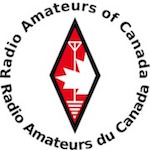

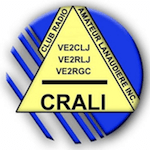
Also a proud member of an international community of solopreneurs
using SoloBuildIt!
(SBI!)
to promote my self-published eBooks
since 2005.
See my review
of this unique product for online businesses.
CQ CQ CQ
If you have a question, a comment or a topic you would like me to cover, please do not hesitate to ask here.
